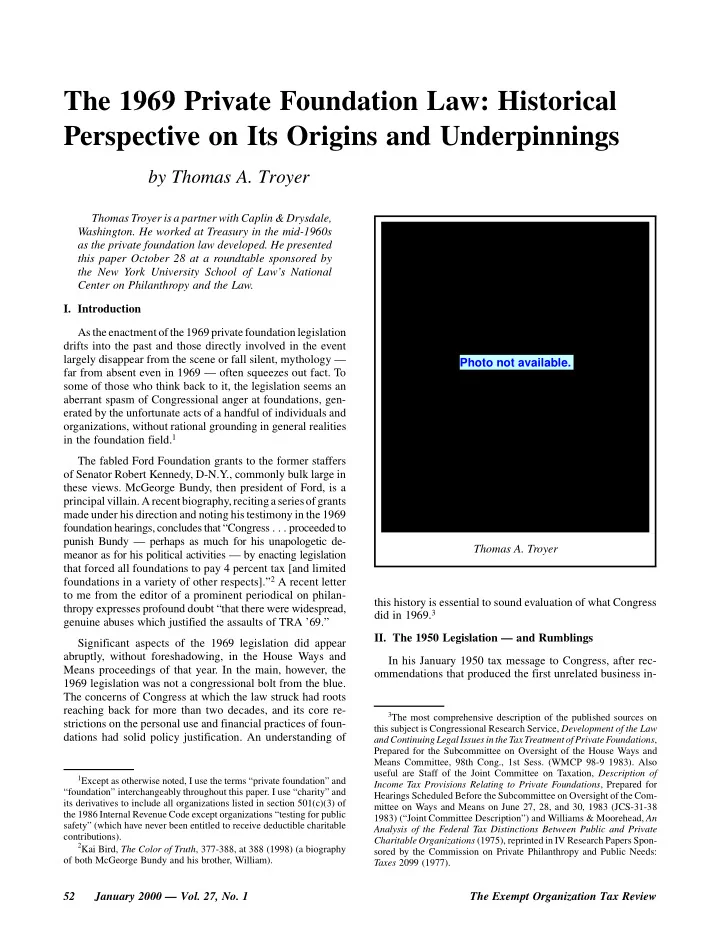

The 1969 Private Foundation Law: Historical Perspective on Its Origins and Underpinnings by Thomas A. Troyer Thomas Troyer is a partner with Caplin & Drysdale, Washington. He worked at Treasury in the mid-1960s as the private foundation law developed. He presented this paper October 28 at a roundtable sponsored by the New York University School of Law’s National Center on Philanthropy and the Law. I. Introduction As the enactment of the 1969 private foundation legislation drifts into the past and those directly involved in the event largely disappear from the scene or fall silent, mythology — Photo not available. far from absent even in 1969 — often squeezes out fact. To some of those who think back to it, the legislation seems an aberrant spasm of Congressional anger at foundations, gen- erated by the unfortunate acts of a handful of individuals and organizations, without rational grounding in general realities in the foundation field. 1 The fabled Ford Foundation grants to the former staffers of Senator Robert Kennedy, D-N.Y., commonly bulk large in these views. McGeorge Bundy, then president of Ford, is a principal villain.A recent biography,recitinga seriesof grants made under his direction and noting his testimony in the 1969 foundation hearings, concludes that “Congress . . . proceeded to punish Bundy — perhaps as much for his unapologetic de- Thomas A. Troyer meanor as for his political activities — by enacting legislation that forced all foundations to pay 4 percent tax [and limited foundations in a variety of other respects].” 2 A recent letter to me from the editor of a prominent periodical on philan- this history is essential to sound evaluation of what Congress thropy expresses profound doubt “that there were widespread, did in 1969. 3 genuine abuses which justified the assaults of TRA ’69.” II. The 1950 Legislation — and Rumblings Significant aspects of the 1969 legislation did appear abruptly, without foreshadowing, in the House Ways and In his January 1950 tax message to Congress, after rec- Means proceedings of that year. In the main, however, the ommendations that produced the first unrelated business in- 1969 legislation was not a congressional bolt from the blue. The concerns of Congress at which the law struck had roots reaching back for more than two decades, and its core re- 3 The most comprehensive description of the published sources on strictions on the personal use and financial practices of foun- this subject is Congressional Research Service, Development of the Law dations had solid policy justification. An understanding of and Continuing Legal Issues in the Tax Treatment of PrivateFoundations , Prepared for the Subcommittee on Oversight of the House Ways and Means Committee, 98th Cong., 1st Sess. (WMCP 98-9 1983). Also useful are Staff of the Joint Committee on Taxation, Description of 1 Except as otherwise noted, I use the terms “private foundation” and Income Tax Provisions Relating to Private Foundations , Prepared for “foundation” interchangeably throughout this paper. I use “charity” and Hearings Scheduled Before the Subcommittee on Oversight of the Com- its derivatives to include all organizations listed in section 501(c)(3) of mittee on Ways and Means on June 27, 28, and 30, 1983 (JCS-31-38 the 1986 Internal Revenue Code except organizations “testing for public 1983) (“Joint Committee Description”) and Williams & Moorehead, An safety” (which have never been entitled to receive deductible charitable Analysis of the Federal Tax Distinctions Between Public and Private contributions). Charitable Organizations (1975), reprinted in IV Research Papers Spon- 2 Kai Bird, The Color of Truth , 377-388, at 388 (1998) (a biography sored by the Commission on Private Philanthropy and Public Needs: of both McGeorge Bundy and his brother, William). Taxes 2099 (1977). 52 January 2000 — Vol. 27, No. 1 The Exempt Organization Tax Review
Recommend
More recommend